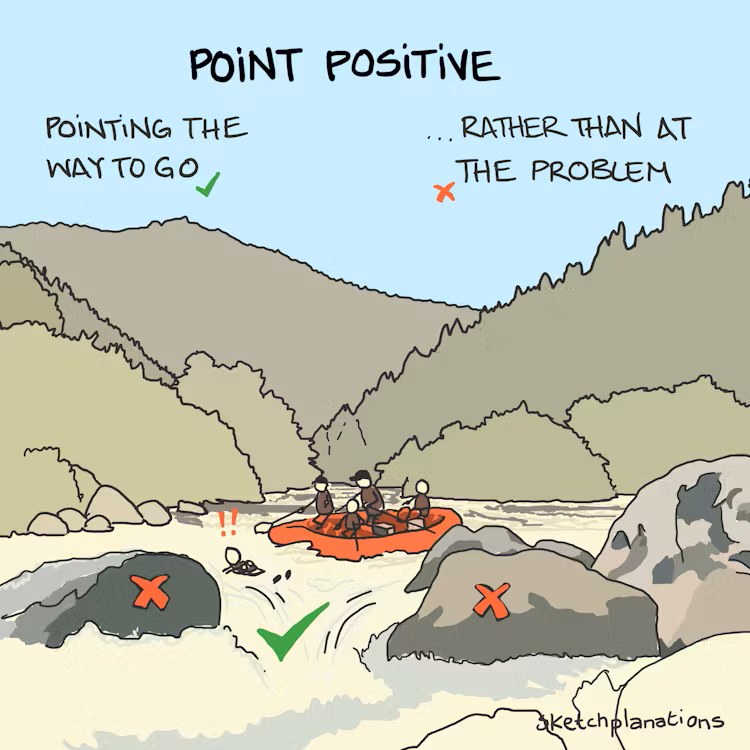Many years ago, while in Australia, I went white water rafting. It was an exhilarating adventure, but the reality of the dangers were brought home to me very sharply when one of the team broke their arm and had to be air lifted to hospital. Staying safe on the rapids is important, but challenging. Communication on the water is difficult, the rapids are loud, dangers are everywhere, and things move incredibly fast. Decisions have to be made quickly, and there is ample opportunity for confusion. I discovered that the guides use a “Point Positive” approach, which means they point in the direction they want you to go, not at the dangers or risks.
“Point Positive” is a principle that is taught to steer clear of dangers while navigating treacherous waters, minimising the information that needs to be conveyed and reducing the chance of misunderstanding. It works like this: when you’re confronted with a dangerous rock or rapid in the river, instead of focusing on the obstacle (the danger), you’re taught to focus on the safe path you want to follow (the positive). You quite literally “point positive,” directing your gaze and the tip of your paddle towards the direction you want to go, rather than towards the obstacle you’re trying to avoid. It is based on the observation that, under stress, we have a natural tendency to steer towards where we’re looking. It’s a principle of focus and direction. In the midst of chaos and danger, Point Positive says keep your sights on the path you want to follow, and steer your energy and action towards the safe and successful route, rather than being overwhelmed by complexity and risk.
The point positive approach has applications far beyond the water. As a leader, one of your most significant roles is to cultivate a productive and positive culture. There are many leadership and motivational theories that promise to do that, but the Point Positive approach is a useful addition for everyone. After all these years I was reminded of it via the wonderful Sketchplanations newsletter and this illustration.

Image: https://sketchplanations.com/point-positive from Sketchplanations
Just like navigating a treacherous river, running an organization or a team can often feel like a constant battle against the current. There are always obstacles to overcome, challenges to navigate, unexpected under currents and risks to avoid. In the face of all these pressures, it’s all too easy to become focused on problems, on what’s going wrong or what could potentially go wrong. But what if we adopt the Point Positive philosophy? That isn’t to say that we ignore risks, or dispense with tackling problems, just that we shouldn’t be consumed by them, letting them pull us away from opportunity and progress. It is better, and more productive, to focus our time and energy on the way forwards.
As we head down the river, new risks will undoubtedly emerge, and if we are still consumed by working out how to deal with the risks that are now past, then we’ll be the ones who end up needing to be airlifted out. Just as the whitewater rafter points their paddle towards the safe path they want to follow, leaders can choose to focus on the positive behaviours and successes they want to cultivate within their teams. By shifting the focus from problems to solutions, from weaknesses to strengths, they steer teams towards success and create a culture that’s built around positivity and growth. By focusing on positive reinforcement, recognising achievements, and building on strengths, rather than dwelling on what’s wrong or what needs fixing, a Point Positive approach amplifies the good, the effective, and the efficient.
So, whether you’re on a raging river or in the boardroom, or dealing with life’s storms, remember to Point Positive. Direct your gaze, your energy, and your actions towards the positive path you want to follow. It will help successfully navigate obstacles and reach your goal.





